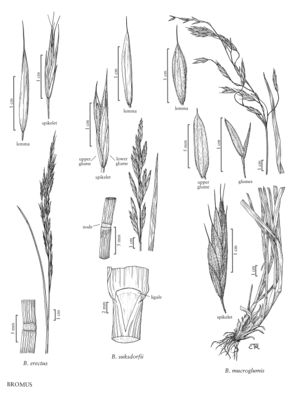Difference between revisions of "Bromus suksdorfii"
imported>Volume Importer |
imported>Volume Importer |
||
| Line 43: | Line 43: | ||
|publication year= | |publication year= | ||
|special status=Endemic | |special status=Endemic | ||
| − | |source xml=https://bitbucket.org/aafc-mbb/fna-data-curation/src/ | + | |source xml=https://bitbucket.org/aafc-mbb/fna-data-curation/src/200273ad09963decb8fc72550212de541d86569d/coarse_grained_fna_xml/V24/V24_306.xml |
|subfamily=Poaceae subfam. Pooideae | |subfamily=Poaceae subfam. Pooideae | ||
|tribe=Poaceae tribe Bromeae | |tribe=Poaceae tribe Bromeae | ||
Latest revision as of 16:22, 11 May 2021
Plants perennial; not rhizomatous. Culms 50-100 cm, erect; nodes 2-3(4), glabrous, internodes glabrous or puberulent just below the nodes. Sheaths glabrous; auricles absent; ligules to 1 mm, glabrous, truncate; blades (8)12-19(24) cm long, 4-8(14) mm wide, flat, glabrous, margins scabrous. Panicles 6-14 cm, erect, contracted; branches erect or ascending. Spikelets 15-30 mm, elliptic to lanceolate, terete to moderately laterally compressed, with (3)5-7 florets. Glumes glabrous or sparsely pubescent; lower glumes 7-11 mm, 1(3)-veined; upper glumes 9-12 mm, 3-veined; lemmas 12-15 mm, elliptic, rounded over the midvein, backs and margins pubescent or nearly glabrous, apices obtuse, entire; awns 2-5 mm, straight, arising less than 1.5 mm below the lemma apices; anthers 2-3.5 mm. 2n = 14.
Distribution
Calif., Wash., Idaho, Nev., Oreg.
Discussion
Bromus suksdorfii grows on open slopes and in open subalpine forests, at about 1300-3300 m, from southern Washington to southern California.
Selected References
None.
